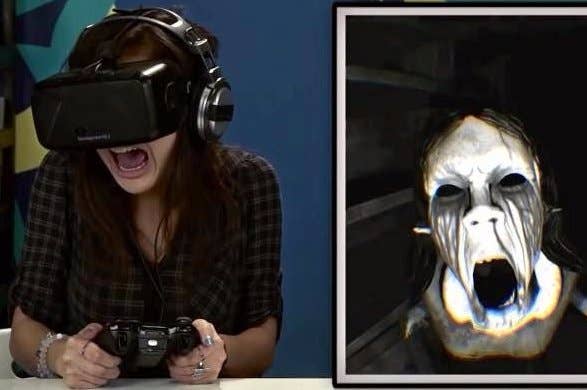VR devs call for restraint on horror games and jump scares
"To throw someone into the most intense experience? We're very against that"
There is much to enjoy at the GDC VR Lounge. Games and 'experiences', in first-person and third, ambient and action-packed, but one in particular has caught the attention of a crowd. They watch as the player spins on the spot, first one way then the other, her mouth slack beneath the bulk of the HTC Vive's headset, a controller gripped in each white-knuckled hand. Every few seconds she screams, a piercing exclamation of what looks very much like legitimate terror. Whether anyone who saw Paranormal Activity at the movies reacted in quite this way seems unlikely. The same subject matter applied to VR, however, is a very different proposition.
"Nope the f*** out of any jump scare kind of game, and try to avoid that. It's really rough on the players"
Owlchemy Labs
In a sense, then, Beast Media Group, the creator of the Paranormal Activity VR experience, has delivered in spades. And yet just a few hours before a panel of developers debated the value of aggressively terrifying experiences as the market for VR software takes shape.
The panel was composed of five developers working with room-scale VR. The moderator, Google's Patrick Hackett, enquired about the medium's strengths, the areas where it is more effective than an experience playing out on a television screen.
"There's one thing that I find it [room-scale VR] does a little too well," said Scott Stephan, design lead at WEVR, the company responsible for the HTC Vive demo, TheBlu: Ecnounter. "I find that scary experiences, horror experiences need to be really finely calibrated. If you see a horror movie on a screen, you have the abstraction. It's not so frightening, and you know you're there for fun.
"I found that, in room-scale VR, things that might be fun on a TV screen, like jump scares... We actually have a rule that no creature should be larger than the size of a small dog. Anything above that and you get this primal, lizard-brain thing of, 'Oh, this isn't a fun scare. It's a survival scare.'
Alex Schwartz, CEO of Job Simulator developer Owlchemy Labs, was more direct, stating that the need for finer calibration was a "soft" way of describing the issue. "I think I would say we would nope the f*** out of any jump scare kind of game, and try to avoid that," he said. "It's really rough on the players. VR is now making gaming and interactive entertainment more accessible than it's ever been, and so to throw someone into the most intense experience? we're very against that. I'd definitely try to push in the opposite direction."
"We're all gonna be taking baby steps. HTC and Facebook have already said '13 and up.' They don't even want to deal with the kids"
Jesse Schell
Stephan referred to the extra "responsibility" involved in the way VR content is presented, and the need to prepare the player for surprising or shocking events. In a traditional game experience, eliciting a visceral reaction might be desirable, but the same content and the same techniques can be heightened to unexpected levels in that new context. Indeed, Stephan even encountered high levels of discomfort among players of early versions of TheBlu - a relatively sedate experience compared to almost any horror game you can mention. WEVR tried to, "mitigate some of that, especially with the use of audio, to be like, 'something is coming. You may not see it, but it's behind you.' You have a responsibility to cue users."
This is not a new concern. In 2014, GamesIndustry.biz watched a similar panel in which Cloudhead Games' Denny Unger described horror games that traffic in jump scares as, "the low-hanging fruit of VR." Unger expressed concern that developers would underestimate just how immersive and powerful VR can be. "When the commercial version comes out, somebody is going to scare somebody to death," he said, "somebody with a heart condition or something like that."
Shortly after the room-scale VR panel concluded, GamesIndustry.biz spoke to Schell Games' Jesse Schell, who has been working with VR since the early Nineties. He was quite clear that he does not share Unger's concerns over VR's potential impact on the physical health of its users, but he also acknowledged that caution and restraint around the user experience is well advised.
"This is really interesting," Schell said. "The weird, twisty irony of it is that VR works better for children than it does for adults, because their imagination is stronger. It's almost like it's perfectly designed for them, but at the same time that may be way too much. We're all gonna be taking baby steps. HTC and Facebook have already said '13 and up.' They don't even want to deal with the kids."

